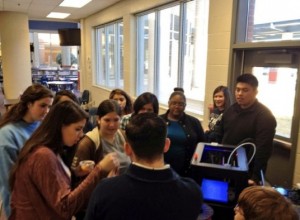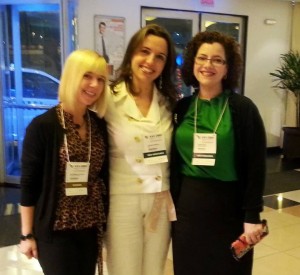As I have been working on my fall course which focuses on collaboration and the instructional role of the school librarian I have been reading a great deal of articles on this topic and one that popped up in my ScoopIt headlines about a month ago drew my interest. It was this post on Forbes called the 12 Habits of Highly Collaborative Organizations. While speaking from the business point of view I saw the parallels in these elements that could certainly be applied to school librarians. Additionally I like that it is from a leadership perspective and how we can get others to buy into collaboration.
1. Focusing on who benefits from the collaboration. I believe this is key when getting teachers to buy into collaboration – you have to stay focused on how their students will benefit from collaborating with you.
2. Strategy before technology. This is something we are all familiar with – the hottest newest technology being purchased with out any planning for implementation and use. In the area of collaboration there is a wealth of new tools out there that can be used by school librarians, teachers, and students – but have a plan how will you use these tools, how will you teach teachers to use these tools and how can they be implemented and utilized in instruction to include students in collaborations.
3. Learn to get out of the way. Don’t stifle collaboration by enforcing too many rules and policies. Be open to spontaneous collaboration opportunities! The last thing a teacher wants to hear is oh yes we can work together on something but I’m going to need you to fill out this form and give me three days notice. Being flexible and fluid are characteristics of any good school librarian – collaboration opportunities may pop up at times you never expect them!
4. Listen to others! Educating children is a group effort and as the school librarian we are an important part of this process, but it is important to always remember that you are just a part – always listen to others and their ideas, suggestions, and feedback then integrate this into your planning and program.
5. Lead by example. As Empowering Learners (AASL, 2009) states school librarians should be leaders. Again I think by modeling good collaborative practices with other school librarians, administrators, and teachers we can help create a collaborative culture in our schools.
6. Integrate the flow of work. Teachers have a great deal on their plates and the last thing they want is “one more thing” they have to do. Make collaboration an integrated part of their curriculum and what they are already responsible for teaching. Show them that collaborating with you is not one more thing, but can help to ease their burden.
7. Create a supportive environment. Is your library a supportive environment for collaboration? Is it welcoming for teachers and are you approachable? Do you provide training for teachers to support them in their efforts with instruction? Do you provide an environment that encourages the use of new technologies for collaboration? Think about what sort of support and environment for learning that you provide as you start off this new school year.
8. Measure what matters. There are many things you can evaluate and measure about your school library program, but are you looking at what matters? Collaborative experiences and how they impact student learning is what matters – not how many books were checked out or how many AR tests were taken. Are you measuring what matters?
9. Persistence! I tell my students that collaboration is an every day effort. It is not something that is going to come easily and does require work and building relationships with teachers. You will not experience success every time and you will not get every teacher to work with you, but you cannot be discouraged – you must be persistent and keep on reaching out to teachers.
10. Adapt and evolve. No two words are truer than these two words in describing school librarians. We have to adapt and evolve as the needs of our students change and as our profession as a whole evolves to stay current and relevant. Also in collaborating, adapt to what works for the teachers in your schools and evolve to utilize the new collaboration tools. Stay up to date and current what is going on in the profession and the world of education – this will allow you to anticipate change and evolve too.
11. Collaboration benefits the user. In our case collaboration should benefit our students. We all have different skills and areas of expertise – when we collaborate we can give our students the best of what each person has to offer. Also we can collaborate with others outside of our buildings to bring in experts in all areas and it has become increasingly easier with technologies such as Sykpe and Google Hangout to bring experts from all over the world into our classrooms. Think bout collaborating on a larger scale – what experts can you tap to provide authentic learning experiences for your students?
12. Collaboration makes the world a better place! Collaboration is an essential element of the school librarian’s world and will most definitely make a difference in how you are able to do your job. It also makes life easier for teachers, they may not know it yet, but as soon as you show them they will see how collaborating to design instruction and co-teach required standards can make things better for them and their students. And finally it is all about the students and their success and they can only benefit from collaboration – whether it is between school librarians and teachers, school librarians and other school librarians, or even with experts from around the world.
As you forge through into this new school year think abut these 12 habits and question yourself and your own practices. Just writing this blog post made me think about my own practices and maybe how I am not doing all I can to create a highly collaborative learning environment for my own students and I have already begun brainstorming ideas on ways to work on this.
References
American Association of School Librarians. (2009). Empowering Learners: Guidelines for school library media programs. Chicago, IL: AASL.
Morgan, J. (July, 2013). 12 habits of highly collaborative organizations. Forbes. Retrieved from http://www.forbes.com/sites/jacobmorgan/2013/07/30/the-12-habits-of-highly-collaborative-organizations/


 AASL Best Apps for Teaching and Learning 2013
AASL Best Apps for Teaching and Learning 2013

